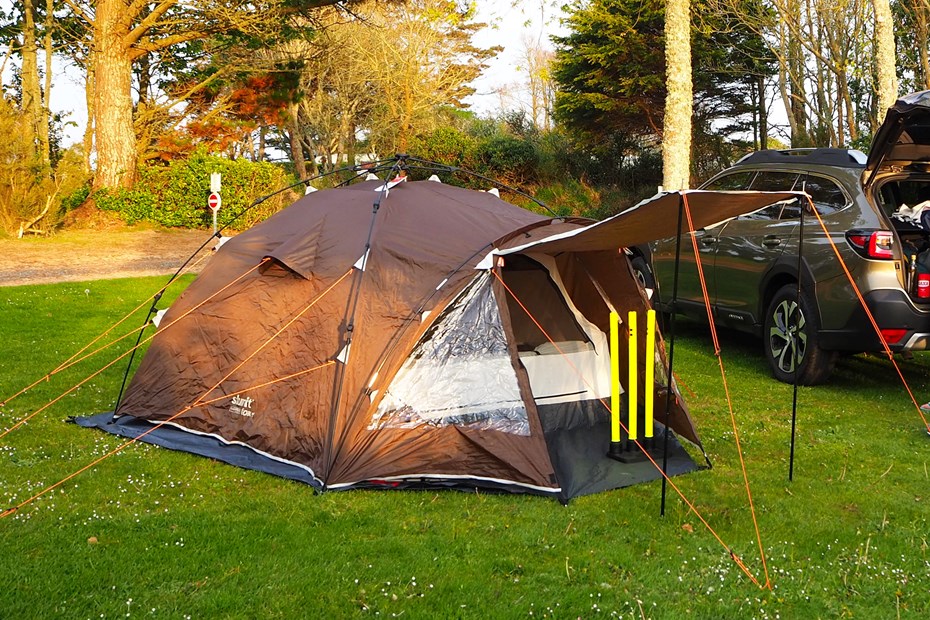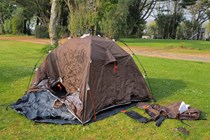Parkers is about cars and vans, so why has a tent snaked through the editor’s fingers to take its place on the front end of the Parkers website? British company Slumit produces tents that feature an interesting and unique design, which allegedly make them ideal to throw in the boot of your car for a quick weekend camping trip.
That’s why Parkers is interested. Tents can often be off-putting for a short one or two night camping trip because of the pitching and setup time. Thus, campervans tend to be allocated the award for Best Spontaneous Camping Accommodation Option. The trouble is, they’re expensive.
Slumit aims to bring convenience and practicality to tenting, and we’ve been testing the mid-size GOBI 3 tent to see if Slumit is onto something.
GOBI 3 design and layout
Slumit’s tents feature a Flashframe. It works by having a foldable frame attached to the tent fabric. With the frame unfolded and tent unpacked on the ground, you simply lift up the frame, which arranges itself into place, and click together the central piece to lock it together. It’s almost the tent equivalent of fast food.

The Slumit range consists of four options: one to four-person sizes, and the GOBI 3 is the second-largest option.
Outside and in, the GOBI 3 looks like a conventional dome-shaped tent. Despite the FlashFrame, nothing else is radically different. You still have a separate fly and inner; a little porch that is generous enough for shoes and other paraphernalia; a zipped door with mesh for keeping bugs out; and a bedroom with storage pockets.
In terms of space, it’s best suited to two people. Three can fit (we tested it), but it is snug and leaves no room for things. Bedroom width and height are both perfectly fine, but people over six foot will find the depth a bit shallow. The sqaure section of the bedroom floor is about two metres deep, with an extra 30 centimetres of tapered space. With a sleeping bag, tall people can be very close to both ends.
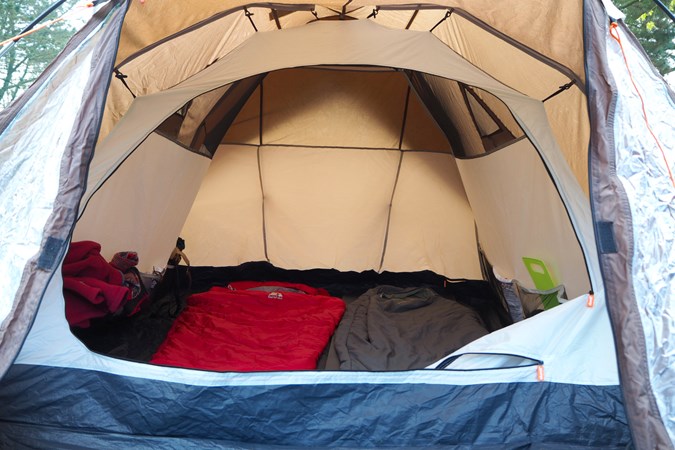
GOBI 3 construction and quality
Most camping tents have a waterproof rating of 3000mm HH (hydrostatic head) for the fly. That probably means nothing to you, but it’s the industry standard unit of measurement for waterproof fabrics. A figure of 3,000 is acceptable for tents and will keep the rain out quite happily. Slumit has improved on this and uses a fabric with 4,000mm HH.
The groundsheet is also above average, with a rating of 10,000mm HH. This gives peace of mind and reassurance that the GOBI 3 will keep any UK rain out. It did indeed rain during our test and the GOBI 3 did a stellar job.
Furthermore, the fly is UV+50 rated, which protects users and the fabric itself. For a sub-£200 tent, we were impressed with the quality of the GOBI 3’s fabric and stitching. Likewise with its breathability. No condensation formed on the inside of the tent, even after a night with three people sleeping in it.
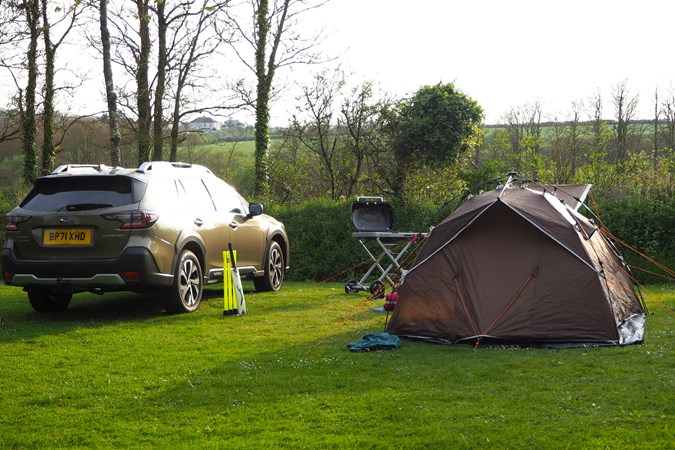
When packed down, the GOBI 3 is larger than other similarly sized tents, due to the chunkier frame. However, it will still fit in the boot of a hatchback, or on the backseat. It’s a similar story with weight. At just under six kilograms, the GOBI 3 is a bit heavier than similar tents but it’s not excessively so.
Any downsides to the GOBI 3?
While the GOBI 3’s exoskeleton certainly makes pitching faster and easier, it’s not as resistant to wind as traditional dome tents. The FlashFrame, used in conjunction with the guy ropes, holds the tent up well, but only in calmer conditions. The GOBI 3 is tested in up to 25mph winds, which is considered a strong breeze, and it isn’t study enough to cope and therefore be exposed to windy conditions.
Another smaller issue is that the poles for the canopy are an extra. Groundsheets and extra guy ropes are reasonable to have as extras, but those poles should be included. Without them, you have to roll up the canopy.
Our final concern is the lack of sustainability efforts here. Outdoor gear brands such as Vaude, The North Face, Rab, Jack Wolfskin, and many others are making efforts to be more sustainable through responsible manufacturing and more eco-friendly fabrics. Slumit makes no such effort, which leaves it sitting with the outdoor brands that don’t appear to care about the environment. It’s not a good look.
Verdict
Slumit’s FlashFlame concept is a good one and achieves what it’s supposed to: making tenting more convenient.
We were impressed with the value and quality of the GOBI 3 and the performance of its fabric. However, there are issues that should be addressed. The relatively instability in wind is a niggle rather than a major fault. People don’t plan to go camping when it’s windy, but it’s useful when a tent can cope if a zephyr turns into something stronger.
The most significant negative is Slumit neglecting sustainability efforts. Customers, particularly outdoorsy types, expect businesses to be making improvements in how they reduce their environmental impact. Having nothing isn’t really acceptable these days.
Score: 3.5/5
Slumit GOBI 3
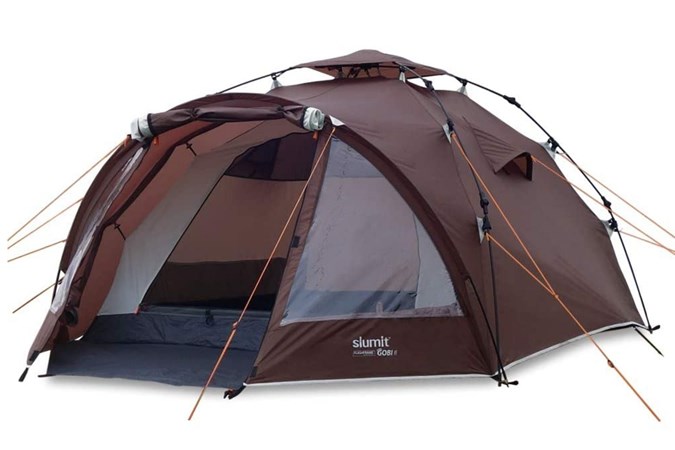
Price: £148.80 | VIEW OFFER
Pros:
• Very easy to pitch
• Great waterproofing
• Breathable
• Affordable
Cons:
• Not a sustainable product
• Not great in windy conditions
Specifications:
Number of people 2-3
Bedroom footprint 200cm x 230cm
Packed size 79 x 19 x 19cm
Weight 5.8kg
Waterproof ratings 4,000mm HH fly, 10,000mm HH groundsheet
More items to consider
Coleman Darwin 3+, RRP £129.99
Jack Wolfskin Skyrocket III Dome, RRP £315
Vango Beta 350 XL, RRP £230
How we tested the Slumit GOBI 3
The GOBI 3 was tested in Cornwall over a long weekend. It was pitched at a campsite and was tested in catering for two and three people. During field testing, the GOBI 3’s waterproofing was assessed following some mild rainfall.
How to clean a tent
Caring for a tent is vital to maintaining its waterproofness and extending its longevity. Cleaning is a major part of this. It’s very easy and our colleagues at Live For The Outdoors have the following advice for you:
‘For cleaning tents you’ll want to use the right cleaning solution, either Grangers Tent + Gear Cleaner or Nikwax Tent & Gear SolarWash. These water-based, PFC-free cleaners don’t damage the fabric or its Durable Water Repellent (DWR) coating. Regular detergents and soaps are not suitable because they’re harsh and can be damaging to the tent fabric.’
1. With the diluted Grangers solution or Nikwax spray, clean the tent in sections and rub the cleaner into the fabric with a clean, damp cloth or sponge.
2. Rinse off each section with clean water as you go. Give your tent an inspection after cleaning to see if there’s any part that needs a second go.
3. If the tent is clean, then leave it to completely dry before packing away. However, if water is no longer beading on the outer tent fabric, it may need reproofing. Luckily, this is as easy as cleaning:
Using Grangers Tent + Gear Repel or Nikwax Tent & Gear Solarproof, evenly spray the outer tent fabric when it is still damp from cleaning. Removing excess residue with a damp cloth, then let the fabric dry. These reproofing sprays add UV protection too.
Sign up to the Parkers Newsletter to keep up to date with more of the latest reviews, news, and recommendations from the Parkers team.
Just so you know, whilst we may receive a commission or other compensation from the links on this page, we never allow this to influence product selections – read why you should trust us.
Just so you know, we may receive a commission or other compensation from the links on this website - read why you should trust us.


